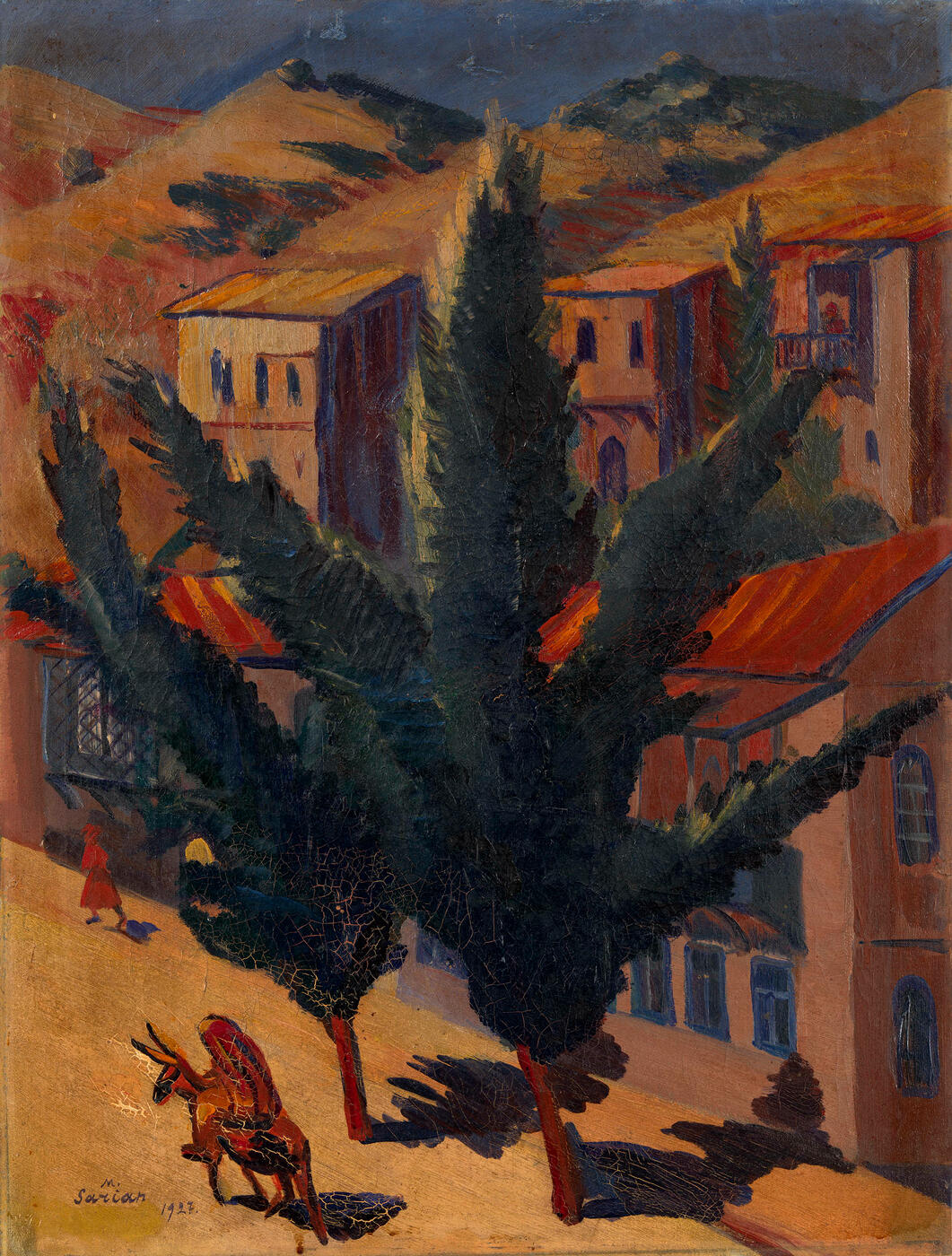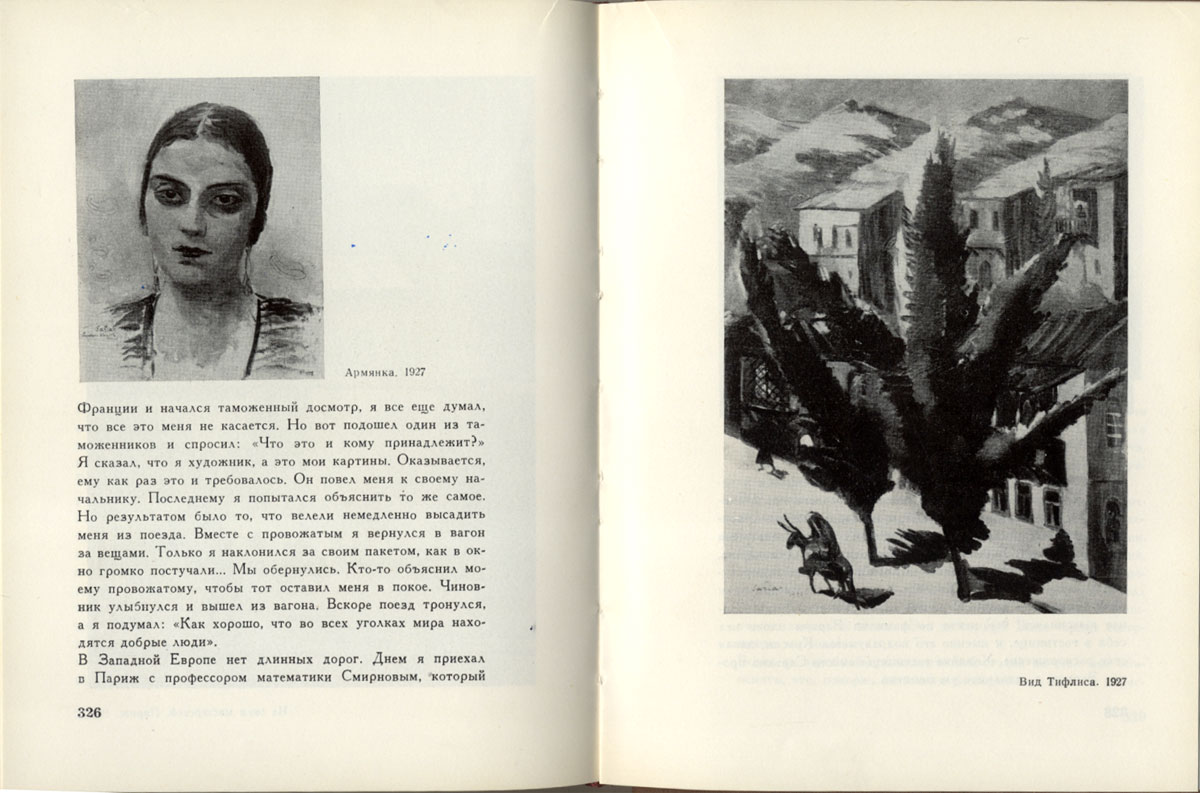MacDougall's Russian Art Auctions 8-9 June 2011
8 June 2011

* 39. SARYAN, MARTIROS (1880-1972)
Rue d'une ville caucasienne (Tiflis), signed and dated 1927, also further signed in Armenian and French and dated on the reverse.
Oil on canvas, 61 by 46 cm.
200,000-300,000 GBP
Provenance: Acquired in Paris from Anna Bugadyan who acted on behalf of the artist.
The Tigran Kelekyan collection, Paris.
Private collection, New Zealand.
Exhibited: Exposition Martiros Sarian, Galerie Charles-Auguste Girard, Paris, 7-20 January 1928, No. 3.
Literature: Exhibition catalogue, Exposition Martiros Sarian, Galerie Charles-Auguste Girard, Paris, 7-20 January 1928, No. 3, listed.
R. Drampyan, Martiros Saryan, Yerevan, 1960 (in Armenian), listed.
M. S. Saryan, Iz moei zhizni, Moscow, Izobrazitel'noe iskusstvo, 1970, p. 326, illustrated as View of Tiflis.
A. Kamensky, Martiros Saryan. Zhivopis', akvareli, risunki, illyustratsii. Teatral'no-dekoratsionnoe iskusstvo. Editors Sh. Khachatouryan, L. Mirozyan, Leningrad, Aurora, 1987, p. 303, listed as "Destroyed in 1928" and illustrated, plate 260.
Martiros Saryan's painting Rue d'une ville caucasienne (Tiflis) - the title under which it was listed in the catalogue for the artist's 1928 solo exhibition in Paris - has a surprising story with an unexpected ending.
After great success at the Venice Biennale of 1924 and at several exhibitions in Moscow, including the first show of the Four Arts Society in 1925, Saryan had the opportunity to go work in Paris. Saryan's Paris period (1926-1928) was extremely productive and greatly significant in terms of undertaking new creative challenges. The solo exhibition, for which the artist was preparing for a year and a half, was to be a kind of summation of everything he had developed and achieved in Paris in a comparatively short time. The style and content of his pictures did not undergo any substantial changes, but the same cannot be said of his painting technique and texture. In Paris, Saryan became even more convinced that he had chosen the right path in making the East - and above all Armenia - the main subject of his art, but for him to realise his new creative goals he needed to develop a rather different technique for painting in oils and eventually to transcend the style of painting dictated by using tempera. His brushstrokes became shorter and more defined, localised colour accents softer, a unified colour palette appeared and the artist used half-tones, for which there had been no place in his early work, more and more frequently. The bright colours became more muted and soft. Saryan was quite consciously reexamining his artistic resources and moving forward towards those goals which life itself placed before him. This is how Alexander Kamensky, in his article "Saryan in Paris", characterised the Paris stage of the artist's creative development: "Thus, for the whole of his Paris period Saryan was moving towards a natural spontaneity in all genres, searching for a human intonation, developing the techniques and approaches needed to recount the real and the everyday. This was essentially a laboratory stage for which the most important and meaningful element turned out to be his efforts to find a new life structure, new forms, a new poetics."
In Paris Saryan painted about 37 pictures and he brought five with him five from Armenia. Thirty-six canvases were hung in the exhibition. At the end of the show, the artist packed up his pictures and dispatched them by sea back to his homeland via the Paquet shipping line. The ship Frigi, with Saryan's paintings in the hold, steered a course from Marseille to Batumi, stopping off at the port of Istanbul. It was here that the fateful event took place. Fire broke out in the hold and all the artist's paintings were burnt. The ship itself was unharmed and continued to sail the waters of the Mediterranean until 1946.
What was known of the fate of Rue d'une ville caucasienne before it
appeared for auction at MacDougall's? How did it escape the tragic fate of Saryan's other Paris works which were burnt in 1928 in the hold of the Frigi? It was painted in 1927 and was first hung as one of the 36 works in the 1928 Saryan exhibition in the Galerie Girard in Paris. In the exhibition catalogue it is listed as "N 3", Rue d'une ville caucasienne (Tiflis). But after the exhibition it transpired that it was not among the works that Saryan sent home by sea - and thank goodness for that.
In the catalogue compiled by the celebrated art historian and director of Armenia's National Picture Gallery, Ruben Grigorievich Drampyan, which was published as early as 1960, it is clearly stated that the picture entitled Rue d'une ville caucasienne was in the Paris collection of Tigran Kelekyan. According to that same catalogue, incidentally, another painting from Saryan's Paris period, Still Life on a Blue Background, also painted in 1927, had likewise ended up in the same private collection. For some reason, both these facts have been ignored in many publications, including the catalogue contained in the book of reproductions Martiros Saryan. Zhivopis', akvareli, risunki,
illyustratsii. Teatral'no-dekoratsionnoe iskusstvo, published by Aurora in 1987, which notes that both works were destroyed.
Ruben Drampyan compiled his catalogue on the basis of information given to him by Saryan himself. The varpet ("master" in Armenian), being a very methodical person, kept records and maintained a register of all the works he painted. His wife, Lusik Lazarevna, assisted him with this. Consequently, there was no good ground for believing that these two works by Saryan were burnt. Their existence came to light and was confirmed in Saryan's letter to Arshak Chopanyan, which we originally published in 2002 in the first volume of Saryan's letters, in which he wrote, among other things, that "I left five pictures in Paris, with Anna Budagyan, one of which has been sold already and the other four are still with her. I left these paintings in the hope that someone might want to acquire them. I would ask you please to arrange with Mr Kelekyan to pay a visit to Miss Budagyan and look at these paintings. Two of them are among my stronger works. These are 1) Armenian Village and 2) Street in a Caucasian Town. There are also Hot Day and Nature morte - with these it's a matter of taste" (28 August, 1928, Yerevan. M. Saryan. Letters (1908-1928). Volume I, p. 506).
Until now we could only judge Rue d'une ville caucasienne (Tiflis)from a black-and-white photograph taken in Paris: it is only now, 83 years after it was painted, that we can see it in colour. It is remarkable both in its technique and composition. As the varpet himself opined, it is one of his "stronger works". The picture is of
exceptional significance for museums and we wish that it could by some miracle find its way to the Saryan House-Museum in Yerevan or, at least, that it might enrich the collection of some European museum.
Rouzan Saryan,
Director of the Martiros Saryan House-Museum


Notes on symbols:
* Indicates 5% Import Duty Charge applies.
Ω Indicates 20% Import Duty Charge applies.
§ Indicates Artist's Resale Right applies.
† Indicates Standard VAT scheme applies, and the rate of 20% VAT will be charged on both hammer price and premium.